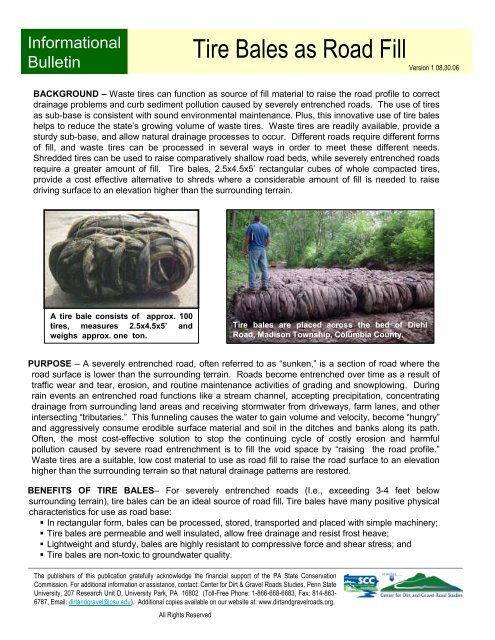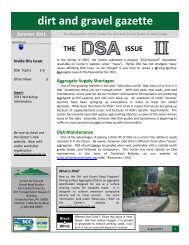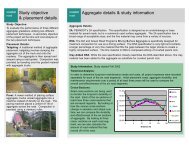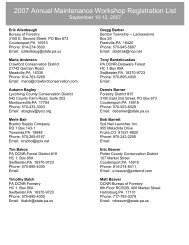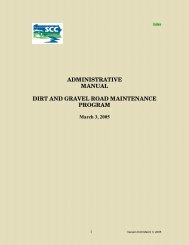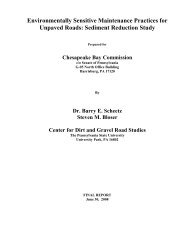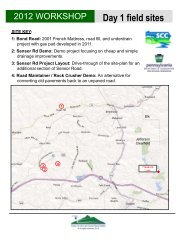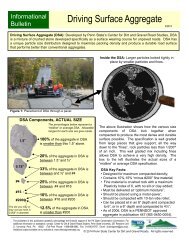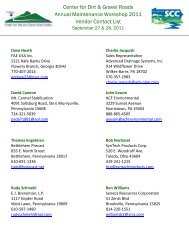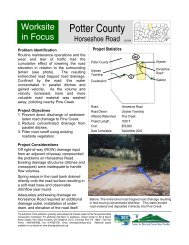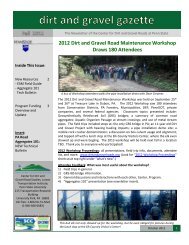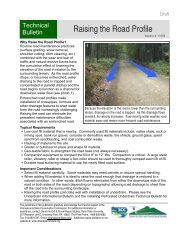Tire Bales as Road Fill Technical Bulletin - Center for Dirt and ...
Tire Bales as Road Fill Technical Bulletin - Center for Dirt and ...
Tire Bales as Road Fill Technical Bulletin - Center for Dirt and ...
Create successful ePaper yourself
Turn your PDF publications into a flip-book with our unique Google optimized e-Paper software.
In<strong>for</strong>mational<br />
<strong>Bulletin</strong><br />
<strong>Tire</strong> <strong>Bales</strong> <strong>as</strong> <strong>Road</strong> <strong>Fill</strong><br />
Version 1 08.30.06<br />
BACKGROUND – W<strong>as</strong>te tires can function <strong>as</strong> source of fill material to raise the road profile to correct<br />
drainage problems <strong>and</strong> curb sediment pollution caused by severely entrenched roads. The use of tires<br />
<strong>as</strong> sub-b<strong>as</strong>e is consistent with sound environmental maintenance. Plus, this innovative use of tire bales<br />
helps to reduce the state’s growing volume of w<strong>as</strong>te tires. W<strong>as</strong>te tires are readily available, provide a<br />
sturdy sub-b<strong>as</strong>e, <strong>and</strong> allow natural drainage processes to occur. Different roads require different <strong>for</strong>ms<br />
of fill, <strong>and</strong> w<strong>as</strong>te tires can be processed in several ways in order to meet these different needs.<br />
Shredded tires can be used to raise comparatively shallow road beds, while severely entrenched roads<br />
require a greater amount of fill. <strong>Tire</strong> bales, 2.5x4.5x5’ rectangular cubes of whole compacted tires,<br />
provide a cost effective alternative to shreds where a considerable amount of fill is needed to raise<br />
driving surface to an elevation higher than the surrounding terrain.<br />
picture<br />
figure<br />
A tire bale consists of approx. 100<br />
tires, me<strong>as</strong>ures 2.5x4.5x5’ <strong>and</strong><br />
weighs approx. one ton.<br />
<strong>Tire</strong> bales are placed across the bed of Diehl<br />
<strong>Road</strong>, Madison Township, Columbia County.<br />
PURPOSE – A severely entrenched road, often referred to <strong>as</strong> “sunken,” is a section of road where the<br />
road surface is lower than the surrounding terrain. <strong>Road</strong>s become entrenched over time <strong>as</strong> a result of<br />
traffic wear <strong>and</strong> tear, erosion, <strong>and</strong> routine maintenance activities of grading <strong>and</strong> snowplowing. During<br />
rain events an entrenched road functions like a stream channel, accepting precipitation, concentrating<br />
drainage from surrounding l<strong>and</strong> are<strong>as</strong> <strong>and</strong> receiving stormwater from driveways, farm lanes, <strong>and</strong> other<br />
intersecting “tributaries.” This funneling causes the water to gain volume <strong>and</strong> velocity, become “hungry”<br />
<strong>and</strong> aggressively consume erodible surface material <strong>and</strong> soil in the ditches <strong>and</strong> banks along its path.<br />
Often, the most cost-effective solution to stop the continuing cycle of costly erosion <strong>and</strong> harmful<br />
pollution caused by severe road entrenchment is to fill the void space by “raising the road profile.”<br />
W<strong>as</strong>te tires are a suitable, low cost material to use <strong>as</strong> road fill to raise the road surface to an elevation<br />
higher than the surrounding terrain so that natural drainage patterns are restored.<br />
BENEFITS OF TIRE BALES– For severely entrenched roads (I.e., exceeding 3-4 feet below<br />
surrounding terrain), tire bales can be an ideal source of road fill. <strong>Tire</strong> bales have many positive physical<br />
characteristics <strong>for</strong> use <strong>as</strong> road b<strong>as</strong>e:<br />
In rectangular <strong>for</strong>m, bales can be processed, stored, transported <strong>and</strong> placed with simple machinery;<br />
<strong>Tire</strong> bales are permeable <strong>and</strong> well insulated, allow free drainage <strong>and</strong> resist frost heave;<br />
Lightweight <strong>and</strong> sturdy, bales are highly resistant to compressive <strong>for</strong>ce <strong>and</strong> shear stress; <strong>and</strong><br />
<strong>Tire</strong> bales are non-toxic to groundwater quality.<br />
The publishers of this publication gratefully acknowledge the financial support of the PA State Conservation<br />
Commission. For additional in<strong>for</strong>mation or <strong>as</strong>sistance, contact: <strong>Center</strong> <strong>for</strong> <strong>Dirt</strong> & Gravel <strong>Road</strong>s Studies, Penn State<br />
University, 207 Research Unit D, University Park, PA 16802 (Toll-Free Phone: 1-866-668-6683, Fax: 814-863-<br />
6787, Email: dirt<strong>and</strong>gravel@psu.edu). Additional copies available on our website at: www.dirt<strong>and</strong>gravelroads.org.<br />
All Rights Reserved
WHERE TO USE – <strong>Tire</strong> bales are ideal <strong>for</strong> roads:<br />
▪ Deeply entrenched causing drainage problems <strong>and</strong><br />
snowplowing difficulties;<br />
In re<strong>as</strong>onable proximity to w<strong>as</strong>te tire source (tire pile).<br />
RAISING THE ROAD PROFILE WITH TIRE<br />
BALES AS SUB-BASE<br />
BEFORE<br />
CONSIDERATIONS – W<strong>as</strong>te tires pose dangerous<br />
health <strong>and</strong> environmental risks when collected in<br />
large piles that provide a breeding ground <strong>for</strong> West<br />
Nile Virus -carrying mosquitoes <strong>and</strong> threaten<br />
cat<strong>as</strong>trophic tire fires. <strong>Tire</strong> bales <strong>as</strong> road fill present<br />
a beneficial end use by eliminating these threats.<br />
TIRE BALE ROADS IN PENNSYLVANIA –<br />
Pennsylvania’s first “tire bale road” h<strong>as</strong> recently<br />
been completed in Jerseytown, Columbia County.<br />
This demonstration involved a nearly mile-long<br />
stretch of the Diehl <strong>Road</strong> <strong>and</strong> incorporated nearly<br />
210,000 w<strong>as</strong>te tires from nearby Starr <strong>Tire</strong> Pile,<br />
home to Pennsylvania’s largest w<strong>as</strong>te tire pile with<br />
an estimated 6-8 million tires. Funds <strong>for</strong> the<br />
project were granted through PA-DEP’s Starr<br />
W<strong>as</strong>te <strong>Tire</strong> Reuse Grant Program, established to<br />
eliminate the pile through application of innovative,<br />
efficient, <strong>and</strong> beneficial w<strong>as</strong>te tire uses. The<br />
program funds projects that create new<br />
products/uses from w<strong>as</strong>te tires <strong>and</strong> encourages<br />
new technology, innovation, <strong>and</strong> the creation of<br />
new markets <strong>and</strong> economic opportunities in local<br />
communities.<br />
DURING<br />
Photo 1<br />
text on pic,<br />
arial 10 bold –<br />
white or black<br />
Photo 2<br />
picture<br />
CONSTRUCTION SEQUENCE<br />
Identify <strong>and</strong> shape severely entrenched<br />
sections <strong>as</strong> necessary to establish slightly<br />
sloped sub-b<strong>as</strong>e to allow drainage to low side.<br />
Set tire bales across the roadbed.<br />
Backfill void spaces in tire bales with fine<br />
grain, well-draining material such <strong>as</strong> s<strong>and</strong> or<br />
bottom <strong>as</strong>h (used at the Diehl <strong>Road</strong> site) <strong>and</strong><br />
spread over the entire tire bale sections.<br />
Apply three (3) distinct 6-inch lifts of shale cap<br />
<strong>and</strong> compact between each layer. Shape<br />
sub-b<strong>as</strong>e to <strong>for</strong>m adequate road crown or<br />
slope (1/2 to 3/4 inch rise per horizontal foot).<br />
Apply 8-inches Driving Surface Aggregate<br />
(DSA) through paving machine <strong>and</strong> compact<br />
to 6-inches with vibratory roller per DSA<br />
placement specification. DSA is abr<strong>as</strong>ion<br />
resistant stone mixture choked with fines <strong>and</strong><br />
placed at optimum moisture to maximize<br />
compaction <strong>for</strong> a durable driving surface.<br />
AFTER<br />
Above: Photo sequence of tire bale section along<br />
Diehl <strong>Road</strong> demonstration site. Compare roadbed to<br />
surrounding vegetation <strong>and</strong> notice how the road<br />
profile h<strong>as</strong> been significantly raised.<br />
This publication is available in alternative media upon request. The Pennsylvania State University is committed to the policy that all persons<br />
shall have equal access to programs, facilities, admission, <strong>and</strong> employment without regard to personal characteristics not related to ability,<br />
per<strong>for</strong>mance, or qualification <strong>as</strong> determined by University policy or by state or federal authorities. The Pennsylvania State University does<br />
not discriminate against any person because of age, ancestry, color, disability or h<strong>and</strong>icap, national origin, race, religious creed, sex, sexual<br />
orientation, or veteran status. Direct all affirmative action inquiries to the Affirmative Action Office, The Pennsylvania State University, 201<br />
Willard Building, University Park, PA 16802-2801; tel. (814) 863-0471; TDD (814) 865-3175. U.Ed #RES-01-50.


